Introduction
Due to Florida's prominence in the exotic pet trade, iguanas imported as pets have escaped or been released, and are now established in South Florida. This has created unique problems for Florida's homeowners and businesses. South and Central Florida's subtropical climate allows these large herbivorous (plant-eating) lizards to survive, reproduce, and become part of the Florida environment. Three large members of the iguana family (Iguanidae) have become established in south Florida. These are the common green iguana (Iguana iguana), the Mexican spiny-tailed iguanas (Ctenosaura pectinata) and black spiny-tailed iguana (C. similis). Large male spiny-tailed iguanas are often misidentified as alligators by startled homeowners because of reduced dorsal spines and dark color. There are many other large lizards established in Florida that some people misidentify as iguanas. The brown basilisk (Basiliscus vittatus) is a large (up to 2 feet) lizard that is often mistaken for an iguana and occurs in the same areas as introduced iguanas. Knight anoles (Anolis equestris) commonly reach between 12–18 inches. Jamaican giant anole (Anolis garmani) males can reach 12 inches. People in South Florida often call these large green anoles "iguanas" or "iguanitos." Occasionally other escaped pets have established breeding populations and are seen by surprised neighbors. These include large lizards like the Nile monitor lizards (Varanus niloticus), the Giant Whiptail (Cnemidophorus motaguae), and the Tegu (Tupinambis sp.).
Identification
See Figures 1 through 9.
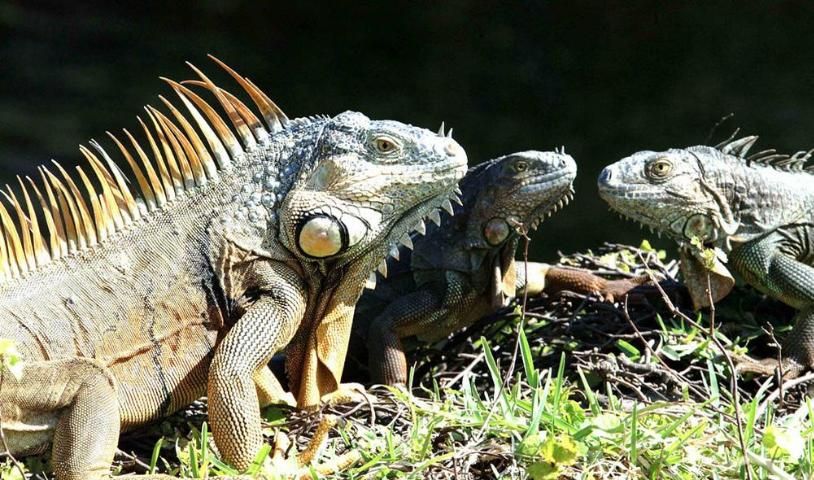
Credit: UF/IFAS
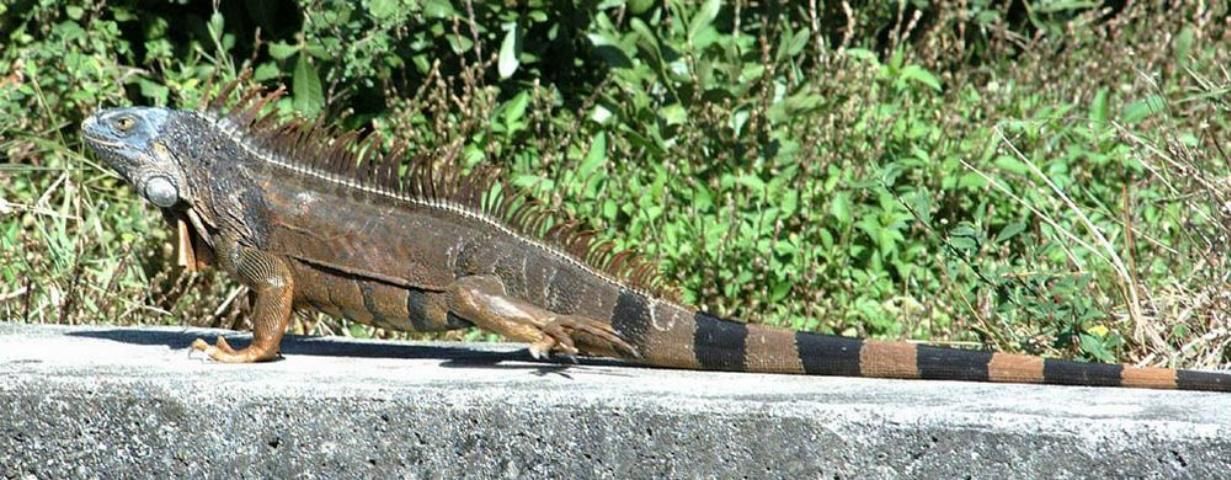
Credit: UF/IFAS
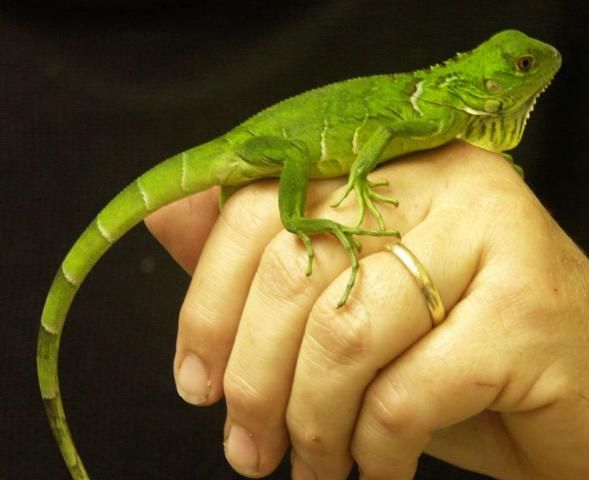
Credit: W. H. Kern, Jr., UF/IFAS
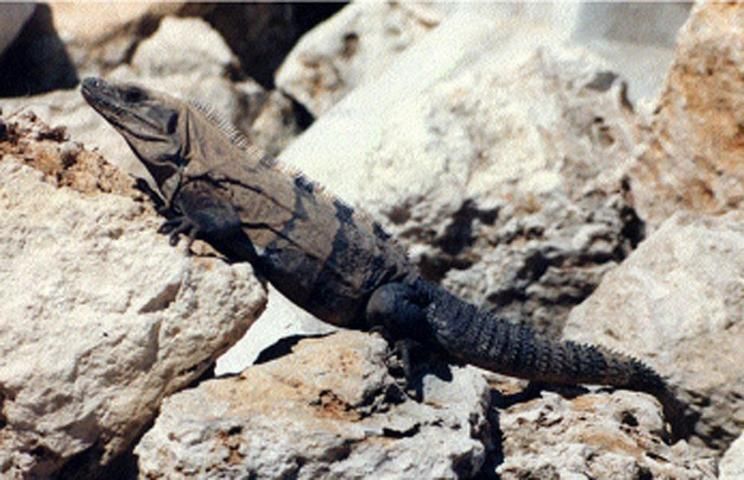
Credit: W. H. Kern, Jr., UF/IFAS
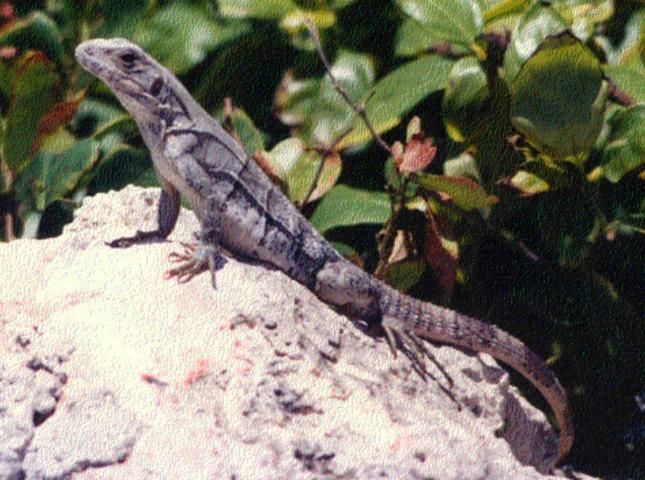
Credit: W. H. Kern, Jr., UF/IFAS
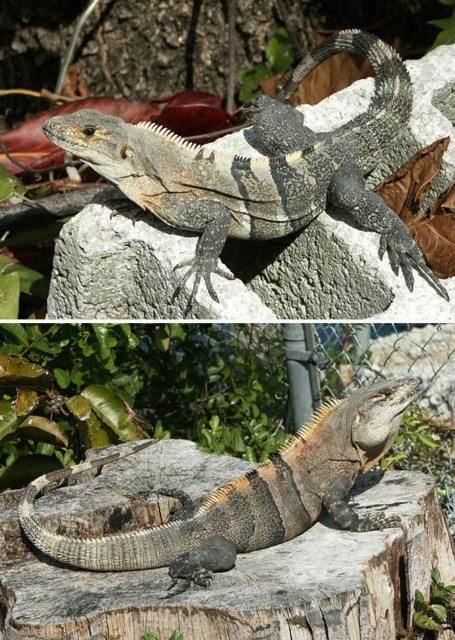
Credit: Vinda B. Maharajh, UF/IFAS
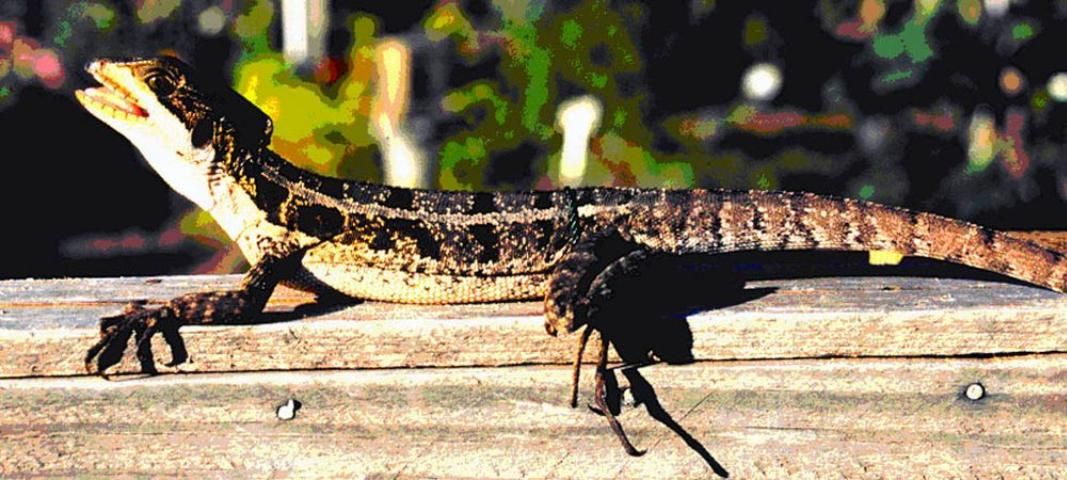
Credit: W. H. Kern, Jr., UF/IFAS
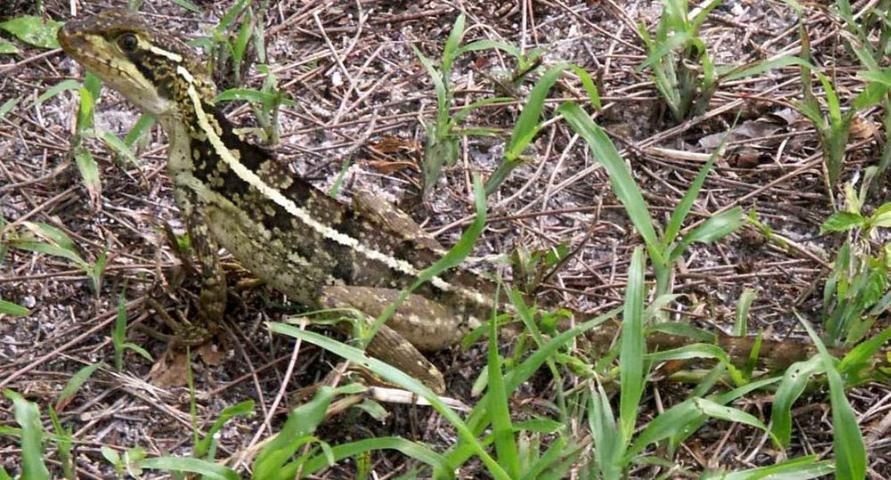
Credit: W. H. Kern, Jr., UF/IFAS
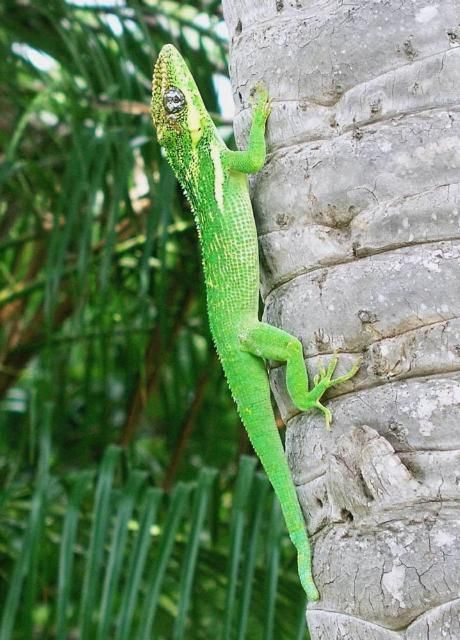
Credit: W. H. Kern, Jr., UF/IFAS
Habits
Adult iguanas are herbivores feeding on foliage, flowers, and fruit. They will occasionally eat animal material such as insects, lizards, and other small animals, nestling birds and eggs. Juveniles eat more animal material, especially insects, and hatchling green iguanas eat the droppings of adult iguanas to acquire the gut bacteria that help them digest plant material. Males are territorial against other males, but are not territorial against females and juveniles. These large lizards like to bask in open areas, sidewalks, docks, seawalls, landscape timbers, or open mowed areas. If frightened, they dive into water (green iguanas and basilisks) or retreat into their burrows (spiny tailed iguanas). This habit of diving into the water to escape makes green iguanas very difficult to capture. Basilisks and anoles generally eat insects and small vertebrate prey, but Knight anoles occasionally eat small fruits and flowers as well.
Damage
Damage caused by iguanas includes eating valuable landscape plants, shrubs, and trees, eating orchids and many other flowers, eating dooryard fruit like berries, figs, mangos, tomatoes, bananas, lychees, etc. Iguanas do not eat citrus. Burrows that they dig undermine sidewalks, seawalls, and foundations. Burrows of iguanas next to seawalls allow erosion and eventual collapse of those seawalls. Droppings of iguanas litter areas where they bask. This is unsightly, causes odor complaints, and is a possible source of salmonella bacteria, a common cause of food poisoning. Adult iguanas are large powerful animals that can bite, cause severe scratch wounds with their extremely sharp claws, and deliver a painful slap with their powerful tail. Iguanas normally avoid people but will defend themselves against pets and people that try to catch them or corner them.
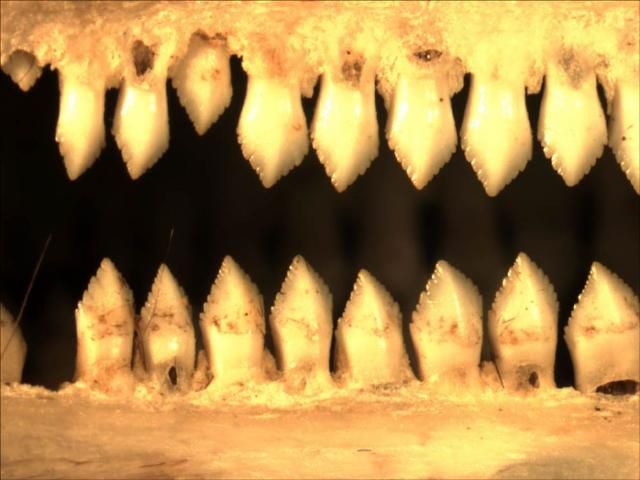
Credit: Karen Wheeler, UF/IFAS
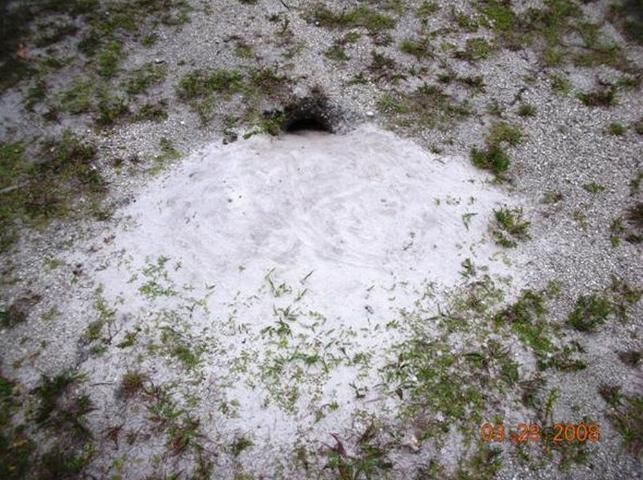
Credit: UF/IFAS
Control Options
Tolerance
Many people enjoy sharing their living space with a few iguanas. Learn to appreciate these exotic creatures. Do not feed iguanas in your yard. This will attract more iguanas and can create problems for both you and your neighbors by creating unnatural concentrations. Do not become a nuisance to your neighbors by feeding iguanas. Pans of cut fruit will attract rats and raccoons as well as iguanas. Be a considerate neighbor and good environmental steward.
Exclusion
Protect valuable plants with cages or screen enclosures. There are currently repellents registered for preventing feeding damage from iguanas. Install sheet metal around trees to prevent them from climbing, about 18 in. from tree base, or create an "L-shaped wire barrier to prevent digging.
Habitat Modification
Avoid planting species that are preferred food for iguanas (See Table 1).
Remove protective cover such as dense thickets and piles of landscape timbers or rocks. Sheet metal guards of trees, palms, and dock pilings will prevent them from climbing. Fill vacant burrows with concrete and sand during the day when the animals are likely to be away from the burrow. Electric fences on seawalls and docks may deter or stop iguanas from climbing up on to them. Persistent harassment will also encourage iguanas to move to safer pastures. Never feed iguanas.
Harassment or Interference with reproduction
Spraying with a water hose, and loud, startling noises are effective in creating an unwelcome atmosphere for basking iguanas. Install CD-ROM discs near sea walls or dangle on trees or other prize plants; change position of CDs often enough so iguanas do not become accustomed to their light reflections.
Build mulch piles or sand piles near sea walls to encourage iguanas to nest in them rather than digging nesting burrows that undermine the sea wall. Open nest, remove eggs, and dispose of them in a sealed plastic bag.
Natural Enemies
Raccoons, fish, crows, vultures, feral pigs, and other predators dig up iguana nests and eat the eggs. Raccoons, snakes, hawks, owls, egrets, herons, cats, and dogs kill the majority of hatchling and juvenile iguanas. After young iguanas reach about two feet in length, they have fewer natural enemies. Automobiles and people are the main cause of mortality of adult iguanas. Alligators may occasionally take adults in the water. In tropical America, large predators like ocelots, pumas, jaguars, anacondas, boa constrictors, and people eat adult iguanas. Dogs occasionally catch iguanas in the open and can overtake them before they escape into the water or down their burrows to safety. Freezes keep iguanas limited to the southern half of peninsular Florida. Chain link fences are another common hazard to larger iguanas. If they get their head and front legs through the openings in the fence but can't squeeze their belly through, they are stuck, unable to back out of the fence.
Capture and Removal
Iguanas can be captured and removed from private property at any time without special permits. They are considered exotic unprotected wildlife. They may be caught by hand, noose pole, net, or traps. Only live traps and snares are legal in the State of Florida. Check with local authorities for any local ordinances that may limit control options.
Do not use poisons or steel traps (leg-hold or body-gripping types) to capture or control nuisance iguanas. No poisons are registered or legal for use on iguanas or any reptiles in Florida.
Babies can be caught by hand or with a thread or monofilament noose on a long bamboo pole. These can be sold or given to pet stores or exotic pet wholesalers. See Figure 3.
It is illegal to release iguanas in Florida (39–4.005 Florida Administrative Code). Iguanas are not native to Florida and so are not protected in Florida, except by anticruelty laws. Green iguanas are listed in the Convention on International Trade in Endangered Species II because of their economic importance and over-harvest for the international pet trade in their native range. In Florida, all captured iguanas must be kept in captivity as pets or captive breeding stock, or must be destroyed. Feral adult iguanas rarely make acceptable pets. They never tame sufficiently and are dangerous. Remember, they can deliver severe bites, scratches and blows with their muscular tails.
Trapping, either with live traps or snares, should be considered a last resort. Traditional live animal traps baited with grapes, pieces of ripe melon, papaya, or mango can be very effective, especially if the traps are prebaited for some time prior to setting the trap. Prebaiting simply means securing the door open and placing food in the trap so the animals get used to entering the trap for food. Once they are regularly entering the trap, release the door and set the trap normally. Florida law requires that animal traps be checked at least once every 24 hours. When trapping iguanas, or any animal, check the trap as often as possible. Iguanas will often get cuts and abrasions when trying to escape from traps. Covering the trap with a burlap bag or old blanket when setting it may reduce this behavior by making the animal feel less exposed or vulnerable. There are many other types of live traps that may catch iguanas, such as funnel entrance traps, etc.
Iguanas and many lizards hold their heads up as they walk or run, to better watch for predators. This behavior makes them ideal candidates for snares. The 24-inch locking snares normally sold for trapping muskrats, mink, or rabbits are large enough for any iguana. Set snares at burrow entrances, holes under fences, along seawalls, or any place that iguanas regularly congregate or move. See Figure 13 on how to set a snare. Snares can kill by strangulation if they are set to do so or the animal struggles too long. Snares cannot discriminate and kill pets or wildlife if not carefully set and monitored. Snares set for iguanas should only be set during the day because that is when iguanas are active, while cats, raccoons, and opossums are generally nocturnal.
During winter cold fronts, cold-stunned iguanas can sometimes be simply picked from branches or picked off the ground after they fall from the trees. Using boats along canals and in the mangroves when the temperatures are in the 40s°F has been very successful. This is a very effective method to reduce local iguana populations.
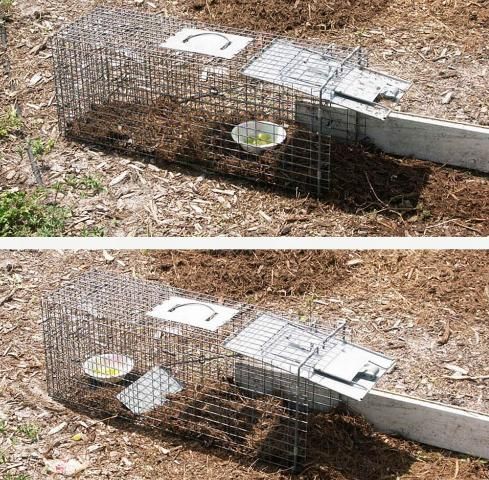
Credit: W. H. Kern, Jr., UF/IFAS
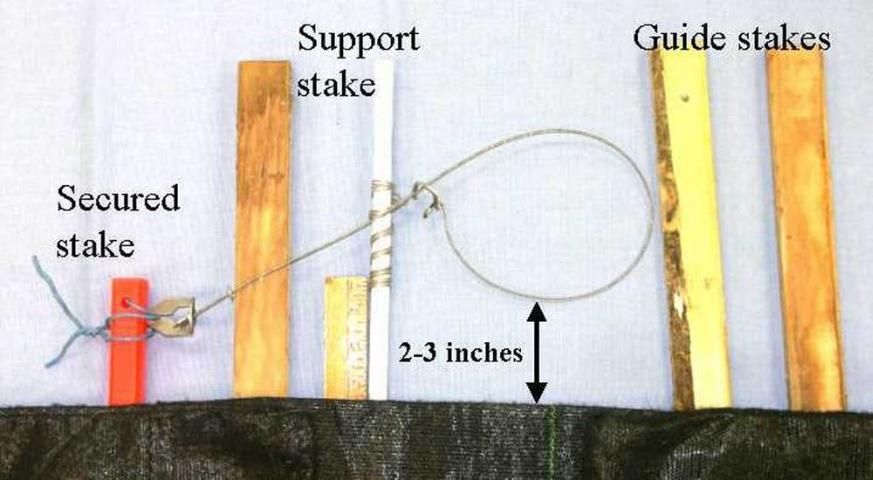
Credit: W. H. Kern, Jr., UF/IFAS
Euthanasia
After a nuisance iguana is captured, the question is "what to do with it?" Because of the large numbers of nuisance iguanas being captured there are limited live donation options available to homeowners. Many wildlife care centers and wildlife rehabilitators don't have the room or resources to care for them. This means that euthanasia is the most humane method of disposal.
These recommendations are from the "Guidelines for Euthanasia of Nondomestic Animals" produced by the American Association of Zoo Veterinarians. The Florida Fish & Wildlife Conservation Commission allows euthanasia of nuisance vertebrates provided any euthanasia shall be humane as defined by the American Association of Zoo Veterinarians.
Euthanasia is not recommended for use by homeowners or the general public. These recommendations are for pest management professionals and can be used by homeowners that choose to euthanize and need to do so legally and humanely.
Recommended method of Euthanasia for Iguanas
Sodium Pentobarbital IV or IC followed by decapitation or deep freezing. This method requires training and certification in lethal injection and this compound is a controlled substance.
Conditionally Acceptable methods of Euthanasia for Iguanas
-
Carbon dioxide chamber, if meat is to be consumed.
-
Halothane, Isoflurane, Sevoflurane administered by a veterinarian.
-
Stunning followed by decapitation.
-
Shooting or stunning with a captive bolt gun followed by decapitation.
-
Cervical dislocation on small juveniles only (<100g).
Unacceptable (Inhumane) forms of Euthanasia for Iguanas
-
Drowning
-
Freezing without prior deep anesthesia
-
Decapitation alone is inhumane because a reptile's brain may remain active for up to a minute following decapitation.
We recommend the hiring of a Nuisance Wildlife Management Professional to trap and dispose of nuisance iguanas, because the public usually has difficulty performing humane euthanasia.
Shooting
Hunting with firearms is a very effective way to harvest iguanas for food in Central and South America. It is not legal or safe to discharge firearms (or pellet rifles) in suburban environments of South Florida where iguanas are commonly causing problems. Shooting is not recommended. Using a bow with tethered fishing arrows may be legal, but the humaneness is debatable. Check with local Florida Fish and Wildlife Conservation Commission officers or local law enforcement before using any projectile weapon. Slingshots with small pebbles or palm fruits may be a useful harassment tool, but should only be used under adult supervision and when you are very sure of your backstop. Rubber band guns have been used by scientists to collect small lizards and may stun juvenile iguanas long enough to capture them by hand.
Eating
The meat of adult iguanas and the eggs are eaten and considered a delicacy throughout their native range, especially during Easter week. As of 2004, the price of iguana meat was $14/pound in Maryland. Large adults, too dangerous to be kept as pets, may have value as meat in ethnic markets that cater to immigrants from Central and South America. However, make arrangements with the market manager before showing up with a sack of iguanas.
Selected References
Ashton, R. E., Jr. and P. S. Ashton. 1985. Handbook of Reptiles and Amphibians of Florida, Part II; Lizards, Turtles & Crocodilians. Miami, FL: Windward Publishing Inc., 191 pp.
Bartlett R. D. and P. P. Bartlett. 1999. A Field Guide to Florida Reptiles and Amphibians. Houston, TX: Gulf Publishing Co., 278 pp.
Stafford, P. J. and J. R. Meyer. 2000. A guide to the reptiles of Belize. San Diego, CA: Academic Press, 356 pp.
Wilson, L. D. and L. Porras. 1983. The Ecological Impact of Man on the South Florida Herpetofauna. Lawrence, KS: Museum of Natural History, University of Kansas, Special Publication No. 9. 89 pp.